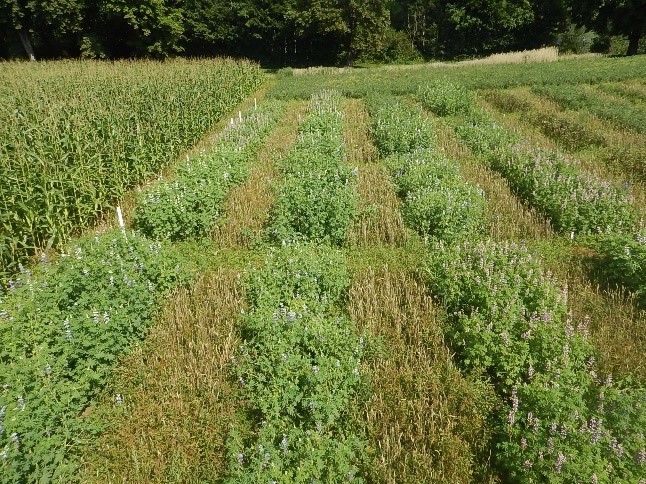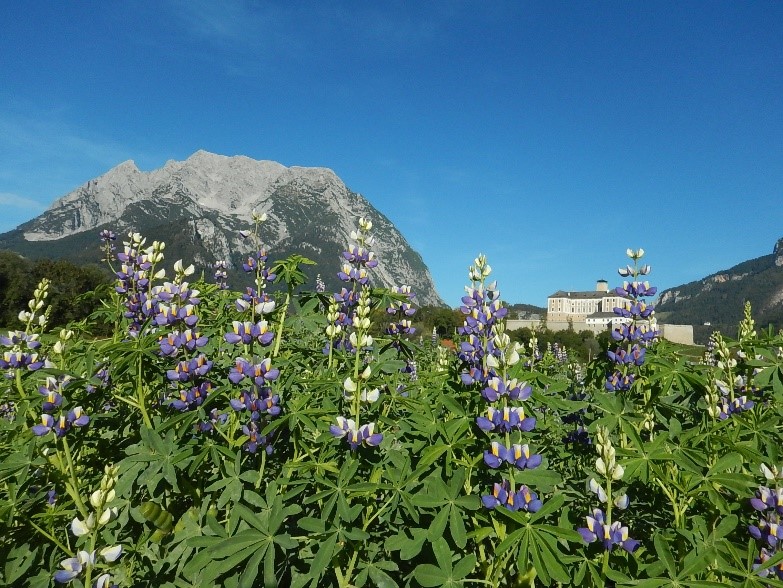Suitability of Andean lupins for cultivation in Austria
Crop development of the Andean lupine
The Andean lupine was cultivated at two different locations in Austria. One location is at the test site in Lambach in Upper Austria in the foothills of the Alps, where two different soils were available. The other location is in an alpine climate, in Trautenfels, at the headquarters of the Bioinstitut.
In the previous experiments it was found that the Andean lupine is sensitive to frost in the seedling stage, which made it necessary to completely cover it with a fleece after cultivation in mid-April in the first year of the experiment due to a particularly cold weather period. It was also shown that Andean lupins do not ripen under normal weather conditions like most other plants, but continue to produce new shoots until the first frost, meaning that buds as well as flowers and pods in different stages of maturity can be observed on the same plant at the same time. This fact makes mechanical harvesting of the pods using a combine harvester impossible in Central Europe; this is only possible due to extreme heat and severe drought in southern countries, where the entire plant ripens and thus becomes a combine crop. In the more northern countries, the Andean lupine receives so much moisture, even during dry periods, that it can continually form new shoots. It was also observed that the ripe pods were shed during a very dry period, but new pods were immediately formed again when the next rainfall began.
In 2019, the crop cultivation trials could only be planted towards the end of the month due to the persistent wet weather in May. Due to the subsequent warmth, the plants at the Trautenfels location sprouted within just five days and developed very well very quickly. At the Lambach site, the tests were only carried out at the beginning of June, so the drought that was already prevailing delayed germination by a few days.
It has also been found that Andean lupine has slow juvenile development when grown earlier and therefore faces strong competition from weed infestation. The prevailing weed flora certainly has an advantage, especially in damp, cool weather conditions. In addition, all other experimenters in this project carry out their experiments conventionally and test different herbicides. In the case of the HBLFA Raumberg-Gumpenstein as a certified organic Austria company, the only option is mechanical weed control, which is done using a harrow, hoe or even by hand.
Various test strains and one variety were available for the plant cultivation experiments. Samples were taken from the single variety during the growing season in 2018 and 2019, from which the yield was determined and the ingredients were analyzed. It was found that the fiber content increased, especially in the stems, and even made up more than half of the stem mass.
When it comes to biomass formation, the Andean lupine is the only variety at the top of all crops that can thrive in these two locations. However, the plant material could not yet be used for animal feed because the alkaloid content is above the permitted threshold. Initial attempts were also made to produce silage from Andean lupine in a mixture with another partner such as green fodder or silage maize. Nevertheless, this use only makes sense once breeding can provide sweet strains.
The project will run until autumn 2020, with plant cultivation trials being carried out again at the HBLFA next year.
Andean lupins as protein plants for a variety of uses

The Andean lupins should be utilized on the one hand via the grains contained in the pods, on the other hand via the entire plant in the form of silage, but also as a biomass feedstock for bio-refineries.
Andean lupins have a protein content of more than 40% and an oil content of more than 20% in their seeds, making them superior to sweet lupins. Lupine protein can be used in the food industry as a substitute for soy protein because the sharp increase in vegetarians and vegans requires a high level of vegetable protein.
In addition to their ability to produce nitrogen as a legume, further positive effects of Andean lupins with regard to crop rotation should be investigated. The use of nutrient-poor soils, which are currently not available for demanding crops, is also being considered after the cultivation of Andean lupins. This could potentially allow industrial wastelands or land not currently used for agriculture to be reintegrated into the agricultural cycle. This aspect is particularly important with regard to the increasingly scarce resource of land.






